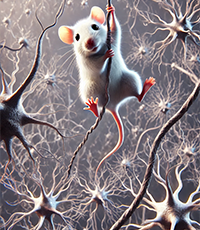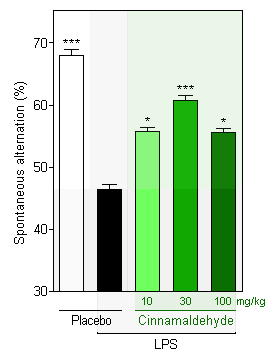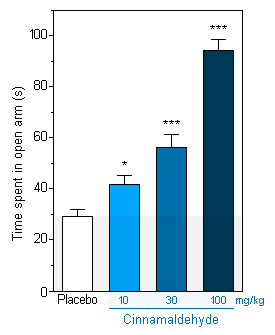Newsletter # 120

In vivo studies
“Cinnamon has been used for centuries, but our research is showing it could have powerful benefits for the brain,” said the study authors. “By improving memory and reducing anxiety, cinnamaldehyde could help support brain health as we age.”
In the meantime, cinnamon remains a popular spice worldwide. Whether sprinkled on oatmeal, added to smoothies, or enjoyed in tea, it's easy to include in your routine. However, while cinnamon may offer health benefits, it’s not a substitute for professional medical treatment.
-
Spontaneous alternation during the T-maze task
Left panel:
Lipopolysaccharide (LPS) challenge is used to model neuroinflammation associated with various cognitive dysfunction conditions. The above graph shows that LPS-challenge markedly impairs the cognitive function of mice as measured by reduced spontaneous alternation during the T-maze task (black vs white column). The decrease in the alternation reflects stereotypic and repetitive behavior, common cognitive symptoms in dementia patients.
The treatment of LPS-challenged mice with Cinnamaldehyde (green columns) significantly increases the alternation level, thus the cognitive performance of mice.
*, p ≤ 0.05; ***, p ≤ 0.001 significantly different as compared to LPS / Placebo group (n = 10 mice per group).
-
Right panel:
The graph shows the anxiety status of mice in the Elevated Plus Maze test (EPM). It is a commonly used test to evaluate the anxiety-like behavior of mice in one single trial. The test is based on an approach/avoidance conflict between the drive to explore novel areas and the aversion to brightly lit, open spaces. Hence, an increase in the time spent in the anxiogenic area (open arms) during the trial is an indication of potential anxiolytic effect of test substances.
Herein, the treatment of mice with Cinnamaldehyde induces a dose-dependent increase in the time spent in the open arms (blue columns) suggesting a reduced anxiety status of mice.
*, p ≤ 0.05; ***, p ≤ 0.001 significantly different as compared to LPS / Placebo group (n = 10 mice per group).
-
We look forward to hearing from you.
Get in touch


 PREVIOUS
PREVIOUS

